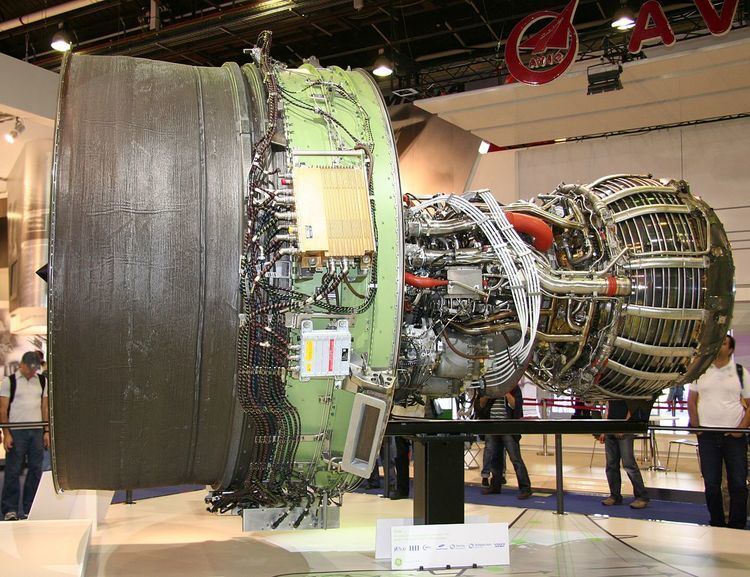 | ||
The General Electric GEnx (General Electric Next-generation) is an advanced dual rotor, axial flow, high-bypass turbofan jet engine in production by GE Aviation for the Boeing 787 and 747-8. The GEnx is intended to replace the CF6 in GE's product line.
Contents
Design and development
The GEnx and the Rolls-Royce Trent 1000 were selected by Boeing following a run-off between the three big engine manufacturers. The GEnx uses some technology from the GE90 turbofan, including composite fan blades, and the smaller core featured in earlier variants of the engine. The engine carries composite technology into the fan case.
Both engine types will have a standard interface with the aircraft, allowing any 787 to be fitted with either GE or RR engines at any time. The engine market for the 787 is estimated at US$40 billion over the next 25 years. A first is the elimination of bleed air systems using high temperature/high pressure air from the propulsion engines to power aircraft systems such as the starting, air-conditioning and anti-ice systems. Both engines enable the move towards the More Electric Aircraft, that is, the concept of replacing previously hydraulic and pneumatic systems with electrical ones to reduce weight, increase efficiency, and reduce maintenance requirements.
The GEnx was expected to produce thrust from 53,000 to 75,000 lbf (240 to 330 kN) with first tests commencing in 2006 and service entry by 2008 (delayed by 787 deliveries). Boeing predicts reduced fuel consumption of up to 20% and significantly quieter engines than current turbofans. A 66,500 lbf (296 kN) thrust version (GEnx-2B67) will be used on the 747-8. Unlike the initial version, for the 787, this version has a traditional bleed air system to power internal pneumatic and ventilation systems. It will also have a smaller overall diameter than the initial model to accommodate installation on the 747.
General Electric began initial test runs of the bleedless GEnx variant on 19 March 2006. The first flight with one of these engines took place on 22 February 2007, using a Boeing 747-100, fitted with one GEnx engine in the number 2 (inboard left hand side) position.
Technical problems
In the summer of 2012, three engines suffered Low Pressure Turbine (LPT) failures; one was caused by an assembly problem, which led to inspections of all other engines then in service. During the spring and summer of 2013, GE learned of four 747-8F freighters that suffered icing in their engines at altitudes of 40,000 feet and above. The most serious incident involved an AirBridge Cargo freighter. On July 31, while at an altitude of 41,000 feet over China, the flight crew noted two engines surging while a third lost substantial power. The pilots were able to land the plane safely, but the engines were found to have sustained damage. Among the possible factors GE cited in an interview with the Wall Street Journal was "'unique convective weather systems' such as unusually large thunderstorms reaching high altitudes." Boeing told the newspaper that it is working with GE on software solutions to the problem.
In March 2016, the Federal Aviation Administration of the United States ordered emergency fixes on the GEnX-1B PIP2 turbofan engine system, due to issues met on in-service aircraft flying in icing conditions. The airworthiness directive affects 43 Boeing 787 Dreamliners in the US, and other nations are expected to follow suit. The fix involves using fan-grinding machinery.
Technology
Despite being derived from the GE90, the GEnx features a number of weight-saving features:
Fuel burn reduction technologies include:
Among features to reduce maintenance cost and increase engine life are:
All of these yield a fuel burn said to be 15% better than GE's CF6-80C2 engines for widebody aircraft.
Applications
Specifications
Data from.
This engine is a dual rotor, axial flow, high bypass ratio turbofan. The 10-stage high-pressure compressor is driven clockwise (Aft Looking Forward) by a 2-stage high-pressure turbine. The single-stage fan and 4-stage low-pressure compressor are driven counterclockwise (Aft Looking Forward) by a 7-stage low-pressure turbine. The engine control system includes a Full Authority Digital Engine Control (FADEC), which has an aircraft connection for digital communication. An engine monitoring unit (EMU) provides vibration level signals to the aircraft.
Notes:
Specifications (GEnx-1B64)
Data from
